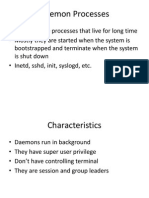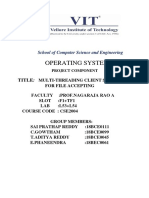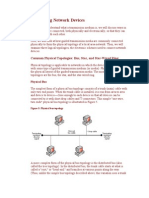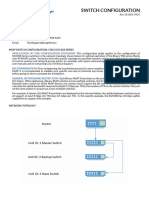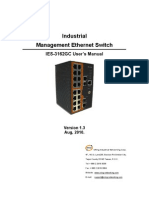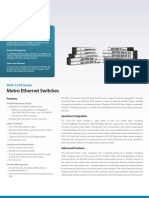TCP Concurrent Echo Program Using Fork and Thread
Uploaded by
Editor IJRITCCTCP Concurrent Echo Program Using Fork and Thread
Uploaded by
Editor IJRITCCInternational Journal on Recent and Innovation Trends in Computing and Communication
Volume: 3 Issue: 4
ISSN: 2321-8169
2225 2229
_______________________________________________________________________________________________
TCP Concurrent Echo Program using Fork and Thread
Ms.Rupilaa V.M., Ms.Sangeetha M., Mr.Sathya Seelan K., Mr.Vadivel R.
Assistant Professor
Adithya Institute of Technology
Abstract In networking, client-server model plays a vital role in exchanging information between processes. Client-server model
predominantly relies on socket programming. Sockets allow communication between processes on same or different machines. Servers in the
client-server model are of two types- Iterative and Concurrent. This paper describes about the elementary socket function for TCP client/server.
An implementation of TCP Echo program for concurrent server using fork and thread is also given.
Keywords Socket, TCP, Concurrent server, fork, thread
__________________________________________________*****_________________________________________________
I.
INTRODUCTION
Rapid growth of Internet leads to the ultimate
development of many net applications which use the clientserver model. Fig. 1 shows the client-server model. Clientserver model allows communication between processes or
applications to exchange some information. The client
process always initiates a connection to the server, while the
server process always waits for requests from any client.
a. Process-based using fork
Spawn one server process to handle each client
connection
Kernel automatically interleaves multiple server
processes
Each server process has its own private address
space
Fig. 2 shows the concurrent server implemented using
fork(). In Fig. 2, client A has already established a
connection with the server, which has created a child server
process to handle the transaction. This allows the server to
process client B request, without waiting for client A to
complete
TCP/IP
Fig. 1 Client-Server Model
Socket is used in client-server application
framework. Sockets are of four types Stream sockets,
datagram sockets, raw sockets and sequenced-packet sockets
[1]. A stream socket uses TCP as end-to-end protocol and of
type SOCK_STREAM. Datagram socket uses UDP as endto-end protocol and of type SOCK_DGRAM. A raw socket
is of type SOCK_RAW and provides raw network protocol
access. A sequenced-packet socket is similar to stream
socket, with the exception that record boundaries are
preserved and of type SOCK_SEQPACKET.
Servers are of two types in client-server model
Iterative server and concurrent server. Iterative server
handles single request at a time and are easy to implement.
Concurrent server handles multiple requests at a time but
difficult to design and build.
Concurrent Server
Concurrent servers are designed using three basic
mechanisms.
a. Process-based using fork
b. Event-based using I/O Multiplexing
c. Threads
Client B
Client A
Concurrent
Child server
process
Fig. 2 Fork Execution Model
b. Event-based using I/O Multiplexing
One process, one thread, but programmer manually
interleaves multiple connections
Relies on lower-level system abstractions
c. Threads
Create one server thread to handle each client
connection
Kernel automatically interleaves multiple server
threads
All threads share the same address space
2225
IJRITCC | April 2015, Available @ http://www.ijritcc.org
_______________________________________________________________________________________
International Journal on Recent and Innovation Trends in Computing and Communication
Volume: 3 Issue: 4
ISSN: 2321-8169
2225 2229
_______________________________________________________________________________________________
close function used to close a socket and terminate a TCP
connection
and
included
in
the
header
file
#include<unistd.h>
Syntax: int close(int sockfd);
Fig. 3 Thread Execution Model
Fig. 3 shows the thread execution model. The main
thread creates peer thread and handles multiple client
requests.
This paper describes about the socket functions and
thread functions used in TCP client-server communication
in section 2. In section 3, the client-server model using
socket function is given. Implementation of concurrent
server using fork and thread is given in subsequent sections.
II.
SOCKET AND THREAD FUNCTIONS
A. SOCKET FUNCTIONS
All the functions used in TCP client/server
communication is defined in the header file
#include<sys/socket.h>.
socket function this function specifies the type of
communication protocol. This function is used by both
client and server.
Syntax: int socket(int family, int type, int protocol);
connect function used by a TCP client to establish a
connection with a TCP server.
Syntax: int connect(int sockfd, const struct sockaddr
*servaddr, socklen_t addrlen);
B. THREAD FUNCTIONS
All the functions are defined in the header file
#include<pthread.h>.
pthread_create create a new thread.
Syntax: int pthread_create(pthread_t *restrict thread, const
pthread_attr_t *restrict attr, void *(*start_routine)(void*),
void *restrict arg);
pthread_self obtain ID of the calling thread.
Syntax: pthread_t pthread_self(void);
pthread_detach detach a thread.
Syntax: int pthread_detach(pthread_t thread);
pthread_exit thread termination
Syntax: void pthread_exit(void *value_ptr);
III.
ELEMENTARY TCP SOCKETS
Fig. 4 shows a timeline of the typical scenario that
takes place between a TCP client and server. First, the
server is started, and sometime later, the client is started and
connects to the server. The client sends a request to the
server, the server processes the request, and the server sends
a reply back to the client. This continues until the client
closes its end of the connection. The server then closes its
end of the connection and either terminates or waits for a
new client connection [3].
bind function assigns a local protocol address to a socket.
Syntax: int bind(int sockfd, const struct sockaddr *myaddr,
socklen_t addrlen);
listen function converts an unconnected socket into a
passive socket and specifies the maximum number of
connections the kernel should queue for this socket. This
function is called only by TCP server. Syntax: int listen(int
sockfd, int backlog);
accept function return the next completed connection
from the front of the completed connection queue.
Syntax: int accept(int sockfd, struct sockaddr *cliaddr,
socklen_t *addrlen);
send function send a message on a socket.
Syntax: ssize_t send(int socket, const void *buffer, size_t
length, int flags);
recv function receive data from a connected socket.
Syntax: ssize_t recv(int socket, void *buffer, size_t length,
int flags);
Fig. 4 Socket functions for elementary TCP client/server
2226
IJRITCC | April 2015, Available @ http://www.ijritcc.org
_______________________________________________________________________________________
International Journal on Recent and Innovation Trends in Computing and Communication
Volume: 3 Issue: 4
ISSN: 2321-8169
2225 2229
_______________________________________________________________________________________________
IV.
close(ls);
return 0;
TCP ECHO CLIENT/SERVER
fgets
stdin
TCP
stdout
client
fputs
send
recv
recv
send
}
TCP
VI.
server
Fig. 5 Echo client/server
Fig. 5 depicts the echo client/server along with the
functions used for input and output. An echo client/server
program performs the following steps:
The client reads a line of text from the standard input
and writes the line to the server.
The server reads the line from the network input and
echoes the line back to the client.
The client reads the echoed line and prints it on its
standard output.
V.
IMPLEMENTATION OF ECHO PROGRAM
FOR CLIENT
#include<stdio.h>
#include<sys/socket.h>
#include<sys/types.h>
#include<netinet/in.h>
void str_echo(int s)
{
char buf[50],buf1[50];
puts("Enter the Message...");
fgets(buf,50,stdin);
IMPLEMENTATION OF ECHO PROGRAM
FOR CONCURRENT SERVER USING FORK
#include<stdio.h>
#include<sys/socket.h>
#include<sys/types.h>
#include<netinet/in.h>
#include<stdlib.h>
void str_echo(int s)
{
char buf[50];
//receiving data from client
recv(s,buf,50,0);
puts("Message from Client...");
fputs(buf,stdout);
send(s,buf,50,0);
}
int main()
{
int ls,cs,len;
struct sockaddr_in serv,cli;
pid_t pid;
send(s,buf,50,0); //sending data to server
puts("I am Server...");
//receiving data from server
recv(s,buf1,50,0);
puts("Message from Server...");
fputs(buf1,stdout);
//creating socket
ls=socket(AF_INET,SOCK_STREAM,0);
puts("Socket Created Successfully...");
}
int main()
{
int ls;
struct sockaddr_in cli;
puts("I am Client...");
/*creating socket*/
ls=socket(AF_INET,SOCK_STREAM,0);
puts("Socket Created Successfully...");
/*socket address structure*/
cli.sin_family=AF_INET;
cli.sin_addr.s_addr=inet_addr("127.0.0.1");
cli.sin_port=htons(5000);
/*connecting to server*/
connect(ls,(struct sockaddr*)&cli,sizeof(cli));
puts("Connected with Server...");
str_echo(ls);
//socket address structure
serv.sin_family=AF_INET;
serv.sin_addr.s_addr=INADDR_ANY;
serv.sin_port=htons(5000);
bind(ls,(struct sockaddr*)&serv,sizeof(serv));
puts("Binding Done...");
listen(ls,3);
puts("Listening for Client...");
for(; ;)
{
len=sizeof(cli);
//accepting client connection
cs=accept(ls,(struct sockaddr*)&cli,&len);
puts("\nConnected to Client...");
//creating child process
if((pid=fork()) == 0)
{
2227
IJRITCC | April 2015, Available @ http://www.ijritcc.org
_______________________________________________________________________________________
International Journal on Recent and Innovation Trends in Computing and Communication
Volume: 3 Issue: 4
ISSN: 2321-8169
2225 2229
_______________________________________________________________________________________________
puts("Child process created...");
close(ls);
str_echo(cs);
close(cs);
exit(0);
Fig. 6 shows the data read from client 1. Fig. 7
shows the data read from client 2. Fig.8 shows the data
processed by concurrent server from client 1 and client 2.
}
close(cs);
}
return 0;
}
VII.
IMPLEMENTATION OF ECHO PROGRAM
FOR CONCURRENT SERVER USING
THREAD
#include<stdio.h>
#include<sys/socket.h>
#include<sys/types.h>
#include<netinet/in.h>
#include<pthread.h>
void str_echo(int s)
{
char buf[20];
recv(s,buf,20,0);
puts("Message from Client...");
fputs(buf,stdout);
send(s,buf,20,0);
}
Fig. 6 Execution of Echo Client 1
static void *doit(void *arg)
{
pthread_detach(pthread_self());
str_echo((int)arg);
close((int)arg);
pthread_exit(0);
return NULL;
}
int main()
{
int ls,cs,len;
Fig. 7 Execution of Echo Client 2
struct sockaddr_in serv,cli;
pid_t pid;
pthread_t th;
puts("I am Server...");
//creating socket
ls=socket(AF_INET,SOCK_STREAM,0);
puts("Socket Created Successfully...");
//socket address structure
serv.sin_family=AF_INET;
serv.sin_addr.s_addr=INADDR_ANY;
serv.sin_port=htons(5000);
bind(ls,(struct sockaddr*)&serv,sizeof(serv));
puts("Binding Done...");
Fig. 8 Execution of Concurrent Echo Server
listen(ls,3);
puts("Listening for Client...");
2228
IJRITCC | April 2015, Available @ http://www.ijritcc.org
_______________________________________________________________________________________
International Journal on Recent and Innovation Trends in Computing and Communication
Volume: 3 Issue: 4
ISSN: 2321-8169
2225 2229
_______________________________________________________________________________________________
for(; ;)
{
len=sizeof(cli);
cs=accept(ls,(struct sockaddr*)&cli,&len);
puts("Connected to Client...");
//creating thread
pthread_create(&th,NULL,&doit,(void *)cs);
}
return 0;
}
VIII.
CONCLUSION
This paper describes about the elementary socket
and thread functions needed for the implementation of
concurrent server. Echo client/server program for concurrent
server using fork and thread is implemented and shown
along with the execution. Synchronization problem exist
with threads which can be overcome by using mutex and
condition variables. To expand the echo client/server into
any application, change what the server does with the input
it receives from its clients.
REFERENCES
Fig. 9 Execution of Echo Client 1
[1] W. Richard Stevens, Unix Network Programming
Vol-I, Second Edition, Pearson Education, 1998.
[2] D.E. Comer, Internetworking with TCP/IP Vol III, (BSD Sockets Version), Second Edition,
Pearson Education, 200 UNIT III
[3] Michael J. Donahoo and Kenneth L. Calvert,
"TCP/IP Sockets in C: Practical Guide for
Programmers",
Second
Edition,
Morgan
Kaufmann, 2001.
[4] Stefan Bocking,Socket++: A Uniform Application
Programming
Interface
for
Basic-Level
Communication Services, IEEE Communication
Magazine December 1996.
[5] Mattew Cook and Syed(shawon)M. Rahman, Java
and C/C++ language feature in terms of Network
Programming, 2005.
[6] https://computing.llnl.gov/tutorials/pthreads/
[7] http://pubs.opengroup.org/onlinepubs/7908799/xsh
/pthread.h.html
Fig. 10 Execution of Echo Client 2
Fig. 11 Execution of Concurrent Echo Server
2229
IJRITCC | April 2015, Available @ http://www.ijritcc.org
_______________________________________________________________________________________
You might also like
- SEED Labs - Firewall Exploration Lab ReportNo ratings yetSEED Labs - Firewall Exploration Lab Report35 pages
- Chapter-10 Parallel Programming Models, Languages and CompilersNo ratings yetChapter-10 Parallel Programming Models, Languages and Compilers30 pages
- Disk Storage, Basic File Structures, and Hashing: Dr. Hasnaa Raafat Dr. Nora ZakieNo ratings yetDisk Storage, Basic File Structures, and Hashing: Dr. Hasnaa Raafat Dr. Nora Zakie31 pages
- Installation of Wire shark, tcpdump, etc and observe data transferred in client server communication using UDP_TCP and identify the UDP_TCP datagramNo ratings yetInstallation of Wire shark, tcpdump, etc and observe data transferred in client server communication using UDP_TCP and identify the UDP_TCP datagram7 pages
- The Barrelfish Operating System: MultiKernel For MulticoresNo ratings yetThe Barrelfish Operating System: MultiKernel For Multicores14 pages
- VTU Exam Question Paper With Solution of 18CS35 Software Engineering May-2021-Dr. Savitha HiremathNo ratings yetVTU Exam Question Paper With Solution of 18CS35 Software Engineering May-2021-Dr. Savitha Hiremath26 pages
- Write A Program To Find The Shortest Path Between Vertices Using Bellman-Ford AlgorithmNo ratings yetWrite A Program To Find The Shortest Path Between Vertices Using Bellman-Ford Algorithm3 pages
- Distributed System (ECS-701) First Mid PaperNo ratings yetDistributed System (ECS-701) First Mid Paper1 page
- CS2402 Mobile and Pervasive Computing SyllabusNo ratings yetCS2402 Mobile and Pervasive Computing Syllabus1 page
- Module-1: Review Questions: Automata Theory and Computability - 15CS54No ratings yetModule-1: Review Questions: Automata Theory and Computability - 15CS544 pages
- 15EC752-Iot & Wireless Sensor Networks - Question Bank Module-1 Overview of Internet of ThingsNo ratings yet15EC752-Iot & Wireless Sensor Networks - Question Bank Module-1 Overview of Internet of Things3 pages
- Data Analytics With R - BDS306C - LAB - FullNo ratings yetData Analytics With R - BDS306C - LAB - Full61 pages
- Module-4 Cloud Computing Architecture PDFNo ratings yetModule-4 Cloud Computing Architecture PDF19 pages
- Chapter 6 (Pipelining and Superscalar Techniques)No ratings yetChapter 6 (Pipelining and Superscalar Techniques)10 pages
- Animal Detection and Prevention in Agri Field Using IotNo ratings yetAnimal Detection and Prevention in Agri Field Using Iot36 pages
- Characterization of Distributed Systems Ds Module1No ratings yetCharacterization of Distributed Systems Ds Module123 pages
- @vtucode - in - CN QUESTION BANK 2021 SCHEMENo ratings yet@vtucode - in - CN QUESTION BANK 2021 SCHEME7 pages
- Real-Time Databases: DR Shamala Subramaniam100% (1)Real-Time Databases: DR Shamala Subramaniam27 pages
- Locating Mobile Entities in Distributed Systems67% (3)Locating Mobile Entities in Distributed Systems2 pages
- Software Quality: Robert Hughes and Mike CotterellNo ratings yetSoftware Quality: Robert Hughes and Mike Cotterell46 pages
- @vtucode - in Previous Year Merged Paper Solution AutomataNo ratings yet@vtucode - in Previous Year Merged Paper Solution Automata42 pages
- Chapter 4: Threads: Silberschatz, Galvin and Gagne ©2009 Operating System Concepts - 8 EditionNo ratings yetChapter 4: Threads: Silberschatz, Galvin and Gagne ©2009 Operating System Concepts - 8 Edition29 pages
- TCP Concurrent Echo Program Using Fork and Thread: Ms - Rupilaa V.M., Ms - Sangeetha M., MR - Sathya Seelan K., MR - Vadivel RNo ratings yetTCP Concurrent Echo Program Using Fork and Thread: Ms - Rupilaa V.M., Ms - Sangeetha M., MR - Sathya Seelan K., MR - Vadivel R5 pages
- Client - Server Architecture: A Basic IntroductionNo ratings yetClient - Server Architecture: A Basic Introduction7 pages
- IJRITCC Call For Papers (October 2016 Issue) Citation in Google Scholar Impact Factor 5.837 DOI (CrossRef USA) For Each Paper, IC Value 5.075No ratings yetIJRITCC Call For Papers (October 2016 Issue) Citation in Google Scholar Impact Factor 5.837 DOI (CrossRef USA) For Each Paper, IC Value 5.0753 pages
- A Review of Wearable Antenna For Body Area Network ApplicationNo ratings yetA Review of Wearable Antenna For Body Area Network Application4 pages
- A Review of 2D &3D Image Steganography TechniquesNo ratings yetA Review of 2D &3D Image Steganography Techniques5 pages
- Channel Estimation Techniques Over MIMO-OFDM SystemNo ratings yetChannel Estimation Techniques Over MIMO-OFDM System4 pages
- Channel Estimation Techniques Over MIMO-OFDM SystemNo ratings yetChannel Estimation Techniques Over MIMO-OFDM System4 pages
- Importance of Similarity Measures in Effective Web Information RetrievalNo ratings yetImportance of Similarity Measures in Effective Web Information Retrieval5 pages
- A Review of Wearable Antenna For Body Area Network ApplicationNo ratings yetA Review of Wearable Antenna For Body Area Network Application4 pages
- A Review of 2D &3D Image Steganography TechniquesNo ratings yetA Review of 2D &3D Image Steganography Techniques5 pages
- Diagnosis and Prognosis of Breast Cancer Using Multi Classification AlgorithmNo ratings yetDiagnosis and Prognosis of Breast Cancer Using Multi Classification Algorithm5 pages
- A Study of Focused Web Crawling TechniquesNo ratings yetA Study of Focused Web Crawling Techniques4 pages
- Predictive Analysis For Diabetes Using Tableau: Dhanamma Jagli Siddhanth KotianNo ratings yetPredictive Analysis For Diabetes Using Tableau: Dhanamma Jagli Siddhanth Kotian3 pages
- Hybrid Algorithm For Enhanced Watermark Security With Robust DetectionNo ratings yetHybrid Algorithm For Enhanced Watermark Security With Robust Detection5 pages
- Safeguarding Data Privacy by Placing Multi-Level Access RestrictionsNo ratings yetSafeguarding Data Privacy by Placing Multi-Level Access Restrictions3 pages
- Image Restoration Techniques Using Fusion To Remove Motion BlurNo ratings yetImage Restoration Techniques Using Fusion To Remove Motion Blur5 pages
- BUSINESS DIARY - An Interactive and Intelligent Platform For SME'sNo ratings yetBUSINESS DIARY - An Interactive and Intelligent Platform For SME's3 pages
- An Approach For Power Control in Vehicular Adhoc Network For Catastrophe MessageNo ratings yetAn Approach For Power Control in Vehicular Adhoc Network For Catastrophe Message7 pages
- Paper On Design and Analysis of Wheel Set Assembly & Disassembly Hydraulic Press MachineNo ratings yetPaper On Design and Analysis of Wheel Set Assembly & Disassembly Hydraulic Press Machine4 pages
- Bechtel Telecommunications Technical Journal100% (3)Bechtel Telecommunications Technical Journal116 pages
- Public Socket (Addressfamily Af, Sockettype ST, Protocoltype PT)No ratings yetPublic Socket (Addressfamily Af, Sockettype ST, Protocoltype PT)10 pages
- IE-5000-12S12P-10G Datasheet: Quick SpecNo ratings yetIE-5000-12S12P-10G Datasheet: Quick Spec4 pages
- Switch Configuration: Cisco Sg550X SeriesNo ratings yetSwitch Configuration: Cisco Sg550X Series4 pages
- MQTT Client DOKU V3-0 PT - Documentos GoogleNo ratings yetMQTT Client DOKU V3-0 PT - Documentos Google89 pages
- Computer Network Assignments: Assignments Based On CS-333 (Computer Networks - I) and CS-343 (Computer Networks - II)No ratings yetComputer Network Assignments: Assignments Based On CS-333 (Computer Networks - I) and CS-343 (Computer Networks - II)9 pages
- Chapter-10 Parallel Programming Models, Languages and CompilersChapter-10 Parallel Programming Models, Languages and Compilers
- Disk Storage, Basic File Structures, and Hashing: Dr. Hasnaa Raafat Dr. Nora ZakieDisk Storage, Basic File Structures, and Hashing: Dr. Hasnaa Raafat Dr. Nora Zakie
- Installation of Wire shark, tcpdump, etc and observe data transferred in client server communication using UDP_TCP and identify the UDP_TCP datagramInstallation of Wire shark, tcpdump, etc and observe data transferred in client server communication using UDP_TCP and identify the UDP_TCP datagram
- The Barrelfish Operating System: MultiKernel For MulticoresThe Barrelfish Operating System: MultiKernel For Multicores
- VTU Exam Question Paper With Solution of 18CS35 Software Engineering May-2021-Dr. Savitha HiremathVTU Exam Question Paper With Solution of 18CS35 Software Engineering May-2021-Dr. Savitha Hiremath
- Write A Program To Find The Shortest Path Between Vertices Using Bellman-Ford AlgorithmWrite A Program To Find The Shortest Path Between Vertices Using Bellman-Ford Algorithm
- Module-1: Review Questions: Automata Theory and Computability - 15CS54Module-1: Review Questions: Automata Theory and Computability - 15CS54
- 15EC752-Iot & Wireless Sensor Networks - Question Bank Module-1 Overview of Internet of Things15EC752-Iot & Wireless Sensor Networks - Question Bank Module-1 Overview of Internet of Things
- Animal Detection and Prevention in Agri Field Using IotAnimal Detection and Prevention in Agri Field Using Iot
- Characterization of Distributed Systems Ds Module1Characterization of Distributed Systems Ds Module1
- Software Quality: Robert Hughes and Mike CotterellSoftware Quality: Robert Hughes and Mike Cotterell
- @vtucode - in Previous Year Merged Paper Solution Automata@vtucode - in Previous Year Merged Paper Solution Automata
- Chapter 4: Threads: Silberschatz, Galvin and Gagne ©2009 Operating System Concepts - 8 EditionChapter 4: Threads: Silberschatz, Galvin and Gagne ©2009 Operating System Concepts - 8 Edition
- TCP Concurrent Echo Program Using Fork and Thread: Ms - Rupilaa V.M., Ms - Sangeetha M., MR - Sathya Seelan K., MR - Vadivel RTCP Concurrent Echo Program Using Fork and Thread: Ms - Rupilaa V.M., Ms - Sangeetha M., MR - Sathya Seelan K., MR - Vadivel R
- Client - Server Architecture: A Basic IntroductionClient - Server Architecture: A Basic Introduction
- IJRITCC Call For Papers (October 2016 Issue) Citation in Google Scholar Impact Factor 5.837 DOI (CrossRef USA) For Each Paper, IC Value 5.075IJRITCC Call For Papers (October 2016 Issue) Citation in Google Scholar Impact Factor 5.837 DOI (CrossRef USA) For Each Paper, IC Value 5.075
- A Review of Wearable Antenna For Body Area Network ApplicationA Review of Wearable Antenna For Body Area Network Application
- Channel Estimation Techniques Over MIMO-OFDM SystemChannel Estimation Techniques Over MIMO-OFDM System
- Channel Estimation Techniques Over MIMO-OFDM SystemChannel Estimation Techniques Over MIMO-OFDM System
- Importance of Similarity Measures in Effective Web Information RetrievalImportance of Similarity Measures in Effective Web Information Retrieval
- A Review of Wearable Antenna For Body Area Network ApplicationA Review of Wearable Antenna For Body Area Network Application
- Diagnosis and Prognosis of Breast Cancer Using Multi Classification AlgorithmDiagnosis and Prognosis of Breast Cancer Using Multi Classification Algorithm
- Predictive Analysis For Diabetes Using Tableau: Dhanamma Jagli Siddhanth KotianPredictive Analysis For Diabetes Using Tableau: Dhanamma Jagli Siddhanth Kotian
- Hybrid Algorithm For Enhanced Watermark Security With Robust DetectionHybrid Algorithm For Enhanced Watermark Security With Robust Detection
- Safeguarding Data Privacy by Placing Multi-Level Access RestrictionsSafeguarding Data Privacy by Placing Multi-Level Access Restrictions
- Image Restoration Techniques Using Fusion To Remove Motion BlurImage Restoration Techniques Using Fusion To Remove Motion Blur
- BUSINESS DIARY - An Interactive and Intelligent Platform For SME'sBUSINESS DIARY - An Interactive and Intelligent Platform For SME's
- An Approach For Power Control in Vehicular Adhoc Network For Catastrophe MessageAn Approach For Power Control in Vehicular Adhoc Network For Catastrophe Message
- Paper On Design and Analysis of Wheel Set Assembly & Disassembly Hydraulic Press MachinePaper On Design and Analysis of Wheel Set Assembly & Disassembly Hydraulic Press Machine
- Public Socket (Addressfamily Af, Sockettype ST, Protocoltype PT)Public Socket (Addressfamily Af, Sockettype ST, Protocoltype PT)
- Computer Network Assignments: Assignments Based On CS-333 (Computer Networks - I) and CS-343 (Computer Networks - II)Computer Network Assignments: Assignments Based On CS-333 (Computer Networks - I) and CS-343 (Computer Networks - II)



